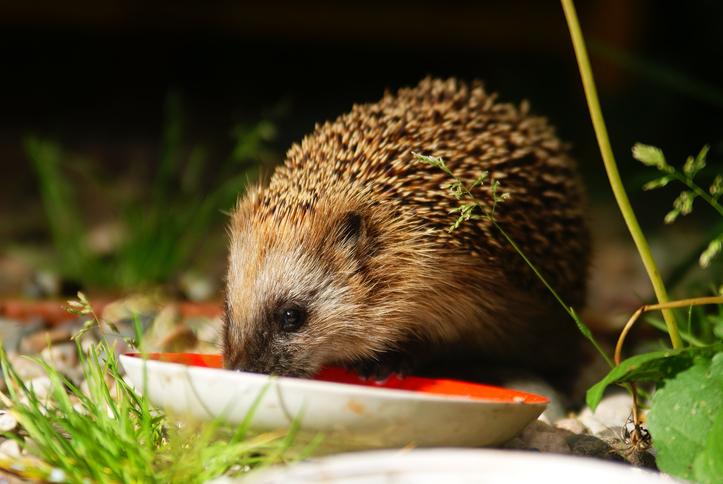
Hibernation is a period of time that frogs, toads, dormice, hedgehogs, bats, mason bees, queen bumblebees, and butterflies are in a state of inactivity.
Hedgehogs tend to hibernate from October through to April, however during mild winters they can still be spotted in November and December. They may also awake from hibernation for a brief period during this time due to a change in temperature. According to the British Hedgehog Preservation Society, their heart rate decreases from 190 bpm to 20 bpm during this state of torpor. Hedgehogs normally hibernate in hibernacula (nests) under hedges, buildings and tree roots, in amongst brushwood and compost heaps, or in burrows. Hedgehogs are found throughout most of Britain, apart from in very wet areas and pine plantations. They unsurprisingly thrive in areas with hedges that abut woodland and fields, or gardens. A hedgehog can have a home range of 10-20 hectares, they can travel 2-3km on a single night.
Unfortunately, hedgehogs are under threat, with a report in 2018 suggesting that their numbers have halved in rural areas and are down by a third in urban areas since 2000. Recently a group of MPs called for hedgehog nesting sites to receive protection. It is currently illegal to kill or capture hedgehogs.
Hedgehogs are generally elusive creatures due to their nocturnal habits. They do leave signs of their presence, however, in the form of tracks and droppings. The tracks look like little handprints with five (or four) toes. Droppings are cylindrical, 15-50 mm, and dark in colour. Tracking tunnels are a great way to get involved with surveying hedgehogs, as they provided conclusive evidence of their presence in an area.

What are the best ways to help support these species?
The hedgehog, as with many species, are prone to the loss and damage of habitat, as this leads to them being deprived of food and shelter from predators. The use of pesticides can also lead to problems, as this can also reduce their food supply. Urban areas also contribute to a loss of habitat and movement around an area, due to impermeable fencing, loss of greenery, and the development of roads.
You can help these spiky creatures by:
- Reducing your use of chemical control - favour of organic methods.
- Making sure fences have a 130 x 130 mm gap in the bottom to give hedgehogs access to your garden and adjoining gardens. A hedgehog hole template can be purchased as a useful indicator of the size of the hole that is needed and then fixed around the hole so people know why it is there.
- Providing a drink of water (avoid other drinks like milk as hedgehogs are lactose intolerant).
- Providing food in the form of dog food or cat biscuits.
- Keeping an area of your garden wild and provide a hedgehog home. Log piles, compost heaps, leaf piles, wildflower patches, and ponds are all hedgehog friendly features to have in your garden, as they provide shelter and encourage insects into the area.
- Checking areas before strimming and mowing, and be aware of hedgehogs under bonfire piles.
- Allowing a method of escape from your pond, by building in a gradual slope.
- Watching out for hedgehogs on roads.
Get involved!
Become a Hedgehog Champion! Hedgehog Street is an initiative that has been set up by the People's Trust for Endangered Species and the British Hedgehog Preservation Society. It's about doing something that will make difference.

Gifts for you and your local hedgehogs
Who doesn't like a cozy home? Wildcare offer a wide range of hedgehog houses, including a protection pack that also includes a glazed ceramic hedgehog snack bowl, a meaty feast, and a detailed hedgehog guide. You should place the hedgehog house in a quiet, sheltered area, and cover it with dried leaves and twigs. Take care not to disturb the house during the summer as if it is being used as a nursery the female could abandon the nest. There should be a period of time after winter hibernation that the house is unoccupied (late March to early April), and therefore available for cleaning. If you treat the house for fleas make sure only to use organic Pyrethrum powers suitable for birds. Do not use dog or cat treatments.
Dinner for hedgehogs: hedgehogs benefit from supplementary feeding. Wildcare stock hedgehog food that provides a tasty and nutritiously balanced meal of rolled oats, sunflower hearts, red maize, kibbled peanuts, vegetable oil, chicken powder, shrimps, small crabs, ground shells, and charcoal. A bowl of fresh water always goes down well with your hogs. Designed to outwit the local foxes and cats, a Hedgehog Feeding Station is always a good addition to the garden ensuring hedgehog food is just for the hedgehogs.

Gorgeous gifts: if you love hedgehogs like we do then we are sure that you will like these elegant offerings from our gift section. These gift items have beautiful hand-drawn images and descriptive text about the hedgehog. What's more 10% of the price is donated to the People's Trust for Endangered Species (PTES).

More information:


